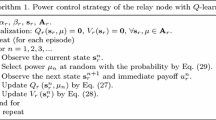Abstract
In this paper, reinforcement learning (RL) based cognitive anti-jamming system employing full duplex tactical radio is investigated under electromagnetic spectrum warfare scenario. Firstly, the analytical expressions of jamming sensing based on improved energy detection are derived to calculate the reward metric. Then, we propose the multidomain anti-jamming strategies based on different learning algorithm and the accurate reward. Simulation results indicate that learning-based cognitive anti-jamming strategies may increase about 25% of the throughput of tactical radio. Moreover, the upper confidence bound and Thompson sampling strategies almost have the same performance and they are superior to other RL anti-jamming schemes.










Similar content being viewed by others
References
Clark, B., & Gunzinger, M. (2015). Winning the air waves—Regaining America’s dominance in the electromagnetic spectrum. Center for Strategic and Budgetary Assessments (CSBA), US.
Wang, B., Wu, Y., Liu, K. R., & Clancy, T. C. (2011). An anti-jamming stochastic game for cognitive radio networks. IEEE Journal on Selected Areas in Communications,29(4), 877–889.
Choe, S., Ko, E., & Jeon, S. (2015). Tactical data link simulator with cognitive anti-jamming capability. In International conference on modeling, simulation and visualization methods (pp. 72–77).
Singh, S., & Trivedi, A. (2012). Anti-jamming in cognitive radio networks using reinforcement learning algorithms. In 2012 ninth international conference on wireless and optical communications networks (WOCN), Indore, India (pp. 1–5).
Bhattarai, S., Jerry Park, J.-M., Gao, B., Bian, K., & Lehr, W. (2016). An overview of dynamic spectrum sharing: Ongoing initiatives, challenges, and a roadmap for future research. IEEE Transactions on Cognitive Communications and Networking,2(2), 110–128.
Aref, M. A., Jayaweera, S. K., & Machuzak, S. (2017, March). Multi-agent reinforcement learning based cognitive anti-jamming. In IEEE wireless communications and networking conference (WCNC’17), San Francisco, CA.
Liu, X., Xu, Y., Jia, L., Wu, Q., et al. Anti-jamming communications using spectrum waterfall: A deep reinforcement learning approach. IEEE Communications Letters, 22(5), 998–1001.
Xiao, L., Li, Y., Liu, J., & Zhao, Y. (2015). Power control with reinforcement learning in cooperative cognitive radio networks against jamming. Journal of Supercomputing,71, 3237–3257.
Han, G., Xiao, L, & Poor, H.V. (2017). Two-dimensional anti-jamming communication based on deep reinforcement learning. In IEEE international conference on acoustics (pp. 2087–2091).
Amjad, M., Akhtar, F., & Rehmani, M. H. (2017). Full-duplex communication in cognitive radio networks: A survey. IEEE Communications Surveys & Tutorials,19(4), 2158–2191.
Bkassiny, M., Jayaweera, S. K., Li, Y., & Avery, K. A. (2012). Wideband spectrum sensing and non-parametric signal classification for autonomous self-learning cognitive radios. IEEE Transactions on Wireless Communications,11(7), 2596–2605.
Wanuga, K., Gulati, N., Saarnisaari, H., & Dandekar, K. R. (2014, June). Online learning for spectrum sensing and reconfigurable antenna control. In 2014 9th international conference on cognitive radio oriented wireless networks and communications (CROWNCOM) (pp. 508–513).
Garnaev, A., Liu, Y., & Trappe, W. (2016). Anti-jamming strategy versus a low-power jamming attack when intelligence of adversary’s attack type is unknown. IEEE Transactions on Signal and Information Processing over Networks,2(1), 49–56.
Wang, Y., Xu, Y., Shen, L., Xu, C., & Cheng, Y. (2014). Two-dimensional POMDP-based opportunistic spectrum access in time-varying environment with fading channels. Journal of Communications and Networks,16(2), 217–226.
Li, H., & Qian, Y. (2017). Effects of IQ imbalance for simultaneous transmit and receive based cognitive anti-jamming receiver. AEU - International Journal of Electronics and Communications,72, 26–32.
Riihonen, T., Korpi, D., Rantula, O., & Valkama, M. (2017, May). On the prospects of full-duplex military radios. In International conference on military communications and information systems, Oulu, Finland.
Li, J., & H. Li. (2016). On the performance of cognitive anti-jamming communication system based on improved energy. In 2nd international conference on communication and information processing, ICCIP (pp. 222–226).
Li, H., & Qian, Y. (2017). Transmit–sense–receive-based cognitive antijamming for airborne ad hoc networks. International Journal of Communication Systems,30(16), 1–10.
Bonnefoi, R., Besson, L., Moy, C., Kaufmann, E., & Palicot, J. (2017). Multi-armed bandit learning in IoT networks and non-stationary settings. In 12th EAI conference on cognitive radio oriented wireless networks (CrownCom), Portugal (pp. 173–185).
Wilhelmi, F., Cano, C., Neu, G., Bellalta, B., Jonsson, A., & Barrachina-Muñoz, S. (2019). Collaborative spatial reuse in wireless networks via selfish multi-armed bandits. Ad Hoc Networks,88(15), 129–141.
Wilhelmi Roca, F., Bellalta, B., Cano Bastidas, C., & Jonsson, A. (2017). Implications of decentralized Q-learning resource allocation in wireless networks. In IEEE 28th annual international symposium on personal, indoor, and mobile radio communications (PIMRC), Montreal, Canada (pp. 8–13).
Funding
Funding was provided by Program of the Aeronautical Science Foundation of China under Grant 2018ZC15003.
Author information
Authors and Affiliations
Corresponding author
Additional information
Publisher's Note
Springer Nature remains neutral with regard to jurisdictional claims in published maps and institutional affiliations.
Rights and permissions
About this article
Cite this article
Li, H., Luo, J. & Li, J. Reinforcement Learning Based Full-Duplex Cognitive Anti-jamming Using Improved Energy Detector. Wireless Pers Commun 111, 2107–2127 (2020). https://doi.org/10.1007/s11277-019-06974-y
Published:
Issue Date:
DOI: https://doi.org/10.1007/s11277-019-06974-y




